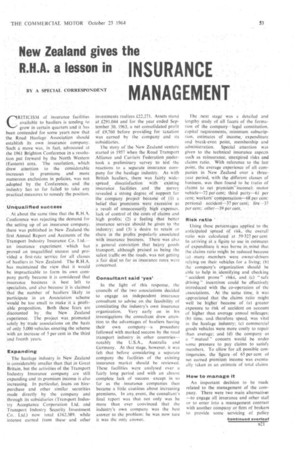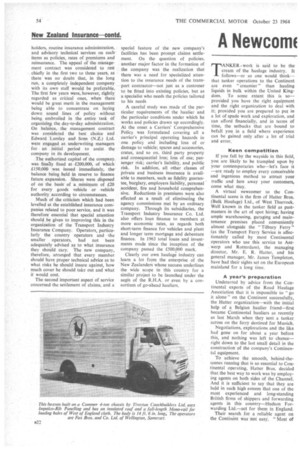New Zealand gives the
Page 55

Page 56

If you've noticed an error in this article please click here to report it so we can fix it.
LILA a lesson in INSURANCE BY A SPECIAL CORRESPONDENT MANAGEMENT CRITICISM of insurance facilities available to hauliers is tending to grow in certain quarters and it has been contended for some years now that the -RoadHaulage Association should establish its own insurance company. Such a move was, in fact, advocated at the 1961 Brighton Conference in a resolu.tion put forward by the North Western (Eastern) area. The resolution, which drew attention to the considerable 'increases ' in premiums and more numerous exclusions in policies, was not ,adopted by the Conference, and the industry has so far failed to take any practical measures to remedy the position,
• •Unqualified success _
At about the same time that the R,H.A. -Conference was rejecting the demand for the setting up of an insurance company, there was published in New Zealand the first 'Annual Report and AccOunts of the -Transpcirt Industry Instirance Co. Ltd.:— -an. insurance experirrient which has .proved an unqualified suctess and proVided a first-rate service for all classes Of hauliers in New Zealand. The R.H.A. has maintained the view that it would he impracticable to form its own c,ompany partly because it is considered that _insurance business is best left to specialists, and also heel-else it is claimed that the number of hauliers likely to participate in an Association scheine :would be too small to Make it a profit7 able proposition. Both these fears are .„discounted by . the New Zealand . .experience. The project was promoted solely by trade associations on the basis of only 5,000 vehicles entering the scheme With an increase of 5 per cent in thethird _and fourth years.
Expanding
The haulage industry in New Zealand is considerably smaller than that in Great Britain. but the activities of the Transport Thdustry Insurance company are still expanding and its premium income is also increasing. In particular, loans on hirepurchase and other similar securities .made directly by the company and through its subsidiaries (Transport Industry Acceptance Corporation Ltd. and Transport Industry Security. Investment Co.. Ltd.) now total £162,189, while interest earned from theseand other
investments realizes £22,271. ASsets stand at £291,044 and for the year ended Septernber 30, 1963, a net consolidated profit of £9,760 before providing for taxation was earned by the company and its subsidiaries.
The story of the New Zealand venture started in 1957 when the Road Transport Alliance and Carriers Federation undertook a preliminary survey to test the reactious to a separate insurance company for the haulage industry. As with British hauliers; ..there was .fairly widespread, dissatisfaction: with existing insurance facilities :,and the survey revealed a strong degree Of support for the company Project' because Of (I) a belief that premiums , Were excessive as a 'result of unnecessarily high' expenses. lack of Control of the casts of claims 'and high Profits; (2) a' feeling that better insurance service should be given to the industry: and (3) 'a desire to retain or share in the profits 'pepularlY associated with insurance business. :Theie waS also a general conviction that heavy goods transport, although Praised its being the safest traffic (NI the fOads, was not getting a fair deal so far as insurance rates Were concerned.
Consultant said 'yes'
In the light of this response, the councils of the two assoeiatiofis deeided to engage an independent ,insurance consultant to advise on , the feasibility of -conStithting the industry's own insurance organization. Very early • on in his investigations the consultant drew attention to the advantages of hauliers having their own company--a procedure followed with marked success by the road transport industry in other countries— notably the U.S.A., Australia and Germany. At that stage, however, it was felt that before considering a separate company the facilities of the eXisting insurance market should be reviewed. These facilities were analysed over a fairly long period. and with an almost complete lack of success—except in so far as the insurance companies then became a little eautibus about increasing premiums. In any, event, the coasultant's .tfnall report was that not only was he more than ever convinced that the Industry's own company was the best answer to the problem: he was now sure it was the only answer.. The _next stage was a detailed and lengthy study of all facets of the formation of the company—legal constitution, capital requirements; minimum subscription, estimates of income, expenditure and break-even point, mennbership and intrninistration: Special attention was given to thetechnical insurance aspects such as reinsurance, unexpired risks and claims ratio. With reference to the last point, the average experience of all companies hi New Zealand t:iter a threeyear period, with th.e different classes of business, was then ,fOund to be (ratio Of claims to net prerninin-income): motor vehicle---72 Per. Cent; third party-6l per cent; WOI'kers' cOrinpenSation=68 per cent; personal accident-37 per cent; fire33 per cent; other-39 per cent.
Risk ratio
Using these percentages applied to the anticipated Spread Of riSk, the overall ratio was calculated at 59.327-per cent In arriving al a figure to use in estimates of expenditure it was borne in,mind that the clairns ratio might be reduced because many members were owner-driVers relying on their; vehicles-• for a living; (h) thc company's organization should be able to help in identifying and checking
" accident prone risks, and (c) " safe driving " incentives could be effectively introduced with the co-operation of the associations. At the mine time, it was appreciated that the elaimS ratio might well be higher' becatise of , (a) greater" exposure to risk of accident on account of higher than average annual mileages; (b) time, andtherefore speed, was vital in the haulage industry; (e) commercial goods vehicles were more costly to repair than aVerage; and (d) the ccimpany as a "mutual concern would be tinder some pressure io pay claims to satisfy members. To allow for all possible contingencies, the figure . of 65 per cent ot net earned premium income was eventually taken as an estimate of total claims How to manage it An important decision to be made related to the management of the company. There were two main alternatives —to engage all insurance and other stall or to enter into a management contract with another company or firm of brokers to provide some servicing of policy
holders, routine insurance administration, and advisory technical services on such items as policies, rates of premiums and reinsurance. The appeal of the management contract was considered to rest chiefly in the first two to three years, as there was no doubt that, in the long run, a completely independent company with its own staff would be preferable. The first few years were, however, rightly regarded as critical ones, when there would be great merit in the management being able to concentrate on laying down sound lines of policy without being embroiled in the entire task of organizing the day-to-day administration. On balance, the management contract was considered the best choice and Edward Lumley and Sons (N.Z.) Ltd. were engaged as underwriting managers for an initial period to assist the company in its development.
The authorized capital of the company. was finallyfixed at £200,000, of which £150,000 was issued immediately, the balance being held in reserve to finance future expansion. Shares were disposed of on the basis of a minimum of £20 for every goods vehicle or vehicle authority according to circumstances.
Much of the criticism which had been levelled at the established insurance companies related to poor service, and it was therefore essential that special attention should be given to improving this in the organization of the Transport Industry Insurance Company. Operators, particularly the country operators and the smaller operators, had not been adequately advised as to what insurance they should cary. The new company, therefore, arranged that every member should have proper technical advice as to what risks he should insure against, how much cover he should take out and what it would cost.
The second important aspect of service concerned the settlement of claims, and a special feature of the new company's facilities has been prompt claims settlement. On the question of policies, another major factor in the formation of the company was the realization that there was a need for specialized attention to the insurance needs of the transport contractor—not just as a customer to be fitted into existing policies, but as a specialist who needs the policies tailored to his needs A careful study was made of the particular requirements of the haulier and the particular Conditions under which he works and policies drawn up accordingly. At the onset a Carriers' Comprehensive Policy was formulated covering all a carrier's principal operating hazards in one policy and including loss of or damage to vehicle; spares and accessories, crates, and so on, third party property and consequential loss; loss of use; passenger risk; carrier's liability, and public risk. In addition, all other classes of private and business insurance is available to members, such as fidelity guarantee, burglary, employers liability, personal accident, fire and household comprehensive. Reductions in premiums were also effected as a result of eliminating the agency commissions met by an ordinary company. Through its subsidiaries, the Transport Industry Insurance Co. Ltd. also offers loan finance to members at more economic rates, as regards both short-term finance for vehicles and plant and longer term mortgage and debenture finance. In 1963 total loans and investments made since the inception of the company passed the £500,000 mark.
Clearly our own haulage industry can learn a lot from the enterprise of the New Zealanders whose success underlines the wide scope in this country for a similar project to be launched under the aegis of the R.H.A. or even by a consortium of go-ahead hauliers.




















































































































